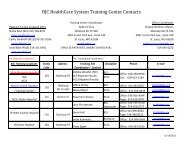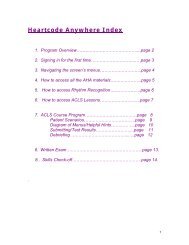A journey filled with love - BJC HealthCare
A journey filled with love - BJC HealthCare
A journey filled with love - BJC HealthCare
You also want an ePaper? Increase the reach of your titles
YUMPU automatically turns print PDFs into web optimized ePapers that Google loves.
A large collage hangs in the Ebeler family<br />
home. In the center is a photo of the firstborn<br />
Ebeler child, Rebecka, who lost her battle<br />
<strong>with</strong> cystic fibrosis (CF) at the age of 12.<br />
Surrounding the photo are words describing<br />
Rebecka, a daughter and sister who is <strong>love</strong>d<br />
and missed — a child who, after a lung<br />
transplant, cleverly composed “An Ode to<br />
My Dear Old Lungs.”<br />
“I said adios to my dear old lungs,” she<br />
wrote in a seemingly lighthearted way.<br />
Rebecka’s siblings made the collage as a<br />
tribute to their sister.<br />
An outlet for intense emotions<br />
Young people <strong>with</strong> serious and life-limiting<br />
illness in the <strong>BJC</strong> pediatric hospice and<br />
supportive care program, Wings, have<br />
experienced an intense set of emotions in<br />
their short life – as have their siblings.<br />
Hope, fear of the unknown, grief, changes in<br />
lifestyle and abilities, and intensified <strong>love</strong> of<br />
family mount to unusual heights.<br />
Expressive therapy, offered by Wings through<br />
Janet Tellatin, MSW, CET, can provide an<br />
outlet for young patients, and their siblings,<br />
for identifying, examining and sharing these<br />
feelings.<br />
What is expressive therapy?<br />
Expressive therapy includes all forms of<br />
artistic expression: paintings, drawings,<br />
Because each day is a gift SM<br />
News from <strong>BJC</strong> Hospice Summer 2008<br />
A <strong>journey</strong> <strong>filled</strong> <strong>with</strong> <strong>love</strong><br />
Expressive therapy releases hopes and fears<br />
clay creations, collages or mask creation;<br />
stories written and illustrated by the child;<br />
photography, especially that done as a<br />
documentary; and sand tray therapy. It also<br />
includes play and movement activities.<br />
“Any of these mediums can help children<br />
safely express what they can’t say in<br />
words, <strong>with</strong> the use of symbols, objects or<br />
metaphors,” Tellatin says. “I might engage a<br />
child in drawing a dream, manipulating a set<br />
of figures in a sand tray, writing a short story<br />
or poem, or using music as an inspiration for<br />
a painting.<br />
“These forms of self-expression can lead to<br />
greater self-understanding and release of<br />
painful or troubled feelings,” she says. “It’s a<br />
way to alleviate thoughts on change and fear<br />
of the unknown.”<br />
Tellatin recalls a young girl, coping <strong>with</strong> her<br />
sister’s recent death, who had been unwilling<br />
to talk about her feelings. When presented<br />
<strong>with</strong> sand and various objects, though, the<br />
girl created an elaborate world of people,<br />
animals and other objects that illustrated her<br />
sister’s death and funeral. She then began to<br />
talk about the world she had created and her<br />
feelings of sadness and longing.<br />
“Sand tray play therapy engages a child in a<br />
world beyond language,” Tellatin says.<br />
Expressive therapy can be an outlet for<br />
releasing the emotions associated <strong>with</strong> the<br />
loss of a sibling, the acceptance of illness,
2<br />
Because each day is a gift<br />
Expressive therapy<br />
continued from page 1<br />
thoughts about afterlife and the stress of<br />
change to one’s daily life. The activities<br />
help to express the fear of the unknown for<br />
oneself and for <strong>love</strong>d ones.<br />
Expressive therapy may also help to celebrate<br />
a strong family <strong>love</strong>, such as the <strong>love</strong> in the<br />
Ebeler household.<br />
Documenting a <strong>journey</strong><br />
Each member of the Ebeler family has his<br />
or her own feelings to sort through. Rachel,<br />
14, also has CF. While adjusting to her own<br />
illness, Rachel still deals <strong>with</strong> the loss of<br />
her sister. Sometimes her expressive activity<br />
is art about Rebecka, such as her painting<br />
of Rebecka as a beautiful angel — the way<br />
Rebecka looked in a dream Rachel had.<br />
Other creations, such as “Rachel’s Story,”<br />
describe her feelings about her own <strong>journey</strong><br />
through CF. “Creating this art and these<br />
stories has helped me let out my feelings,<br />
deal <strong>with</strong> my illness and continue to fight<br />
and hope,” Rachel says.<br />
Her paintings are intense <strong>with</strong> quiet<br />
expressions of struggle, determination and<br />
<strong>love</strong>, Tellatin says. “Art expression offers a<br />
tangible and lasting product that is shared<br />
<strong>with</strong> the family,” Tellatin says.<br />
With Tellatin’s help, Rachel is putting<br />
together a book. She is incorporating her<br />
art and writings into one manuscript that<br />
tells the story of her <strong>journey</strong> <strong>with</strong> CF. She<br />
describes it as “a <strong>journey</strong> <strong>filled</strong> <strong>with</strong> sadness,<br />
scariness, grief and triumph, but most<br />
importantly, <strong>filled</strong> <strong>with</strong> <strong>love</strong>.”<br />
<strong>BJC</strong> Palliative Home Care<br />
Only one of its kind in the St. Louis area<br />
<strong>BJC</strong> Palliative Home Care is a specialized home<br />
health program that caters to the needs of<br />
patients <strong>with</strong> any advanced stage disease. This<br />
program is the only one of its kind in the greater<br />
St. Louis metropolitan area.<br />
“Ninety-five percent of the patients are those<br />
<strong>with</strong> advanced stage cancer who are just not<br />
ready to be in hospice,” says Lynn Anson, <strong>BJC</strong><br />
Palliative Home care manager. “Our staff brings<br />
a wide variety of training to this program.<br />
We have ICU nurses, oncology nurses, charge<br />
nurses from nursing homes and hospice nurses.<br />
Each one of them is specifically trained in pain<br />
and symptom management and have great<br />
knowledge of the side effects of chemotherapy<br />
and radiation. Our job is to meet the patient<br />
where they are at, define the goals and if,<br />
appropriate make a seamless transition to<br />
hospice.”<br />
“I had a spouse of one of our patients call me<br />
recently,” says Anson. “She raved about our<br />
services and said our nurses are so kind and<br />
caring. They never seem like they are rushed and<br />
they always took their time and listened to what<br />
my husband needed.”<br />
Currently, <strong>BJC</strong> Palliative Home Care sees about<br />
135 patients all <strong>with</strong>in a 50 mile radius in the<br />
St. Louis area. Since <strong>BJC</strong> Palliative Home Care<br />
is a home health care program, patients have to<br />
be home bound, have to have a skilled need and<br />
they have to have a doctor’s orders.<br />
Below are drawings from Rachel’s “<strong>journey</strong> <strong>filled</strong> <strong>with</strong><br />
sadness... and <strong>love</strong>.”
<strong>BJC</strong> Hospice will begin seeing patients in<br />
the Farmington and surrounding areas in<br />
the next month, and is currently hiring<br />
individuals and seeking volunteers from the<br />
area. They will be located at 757 Weber<br />
Road in Farmington.<br />
<strong>BJC</strong> Hospice brings 25 years of experience<br />
and compassion to the Parkland area <strong>with</strong><br />
a new menu of services such as massage<br />
therapy for the patient and<br />
caregivers, music therapy,<br />
free support groups<br />
and retreats for ages 6<br />
through adult, extended<br />
bereavement programs for<br />
children and adults and<br />
more.<br />
“In coming to the Parkland<br />
area we will be able to<br />
provide continuity of care<br />
<strong>with</strong>in the <strong>BJC</strong> <strong>HealthCare</strong><br />
system and the community<br />
at large <strong>with</strong> local staff,<br />
familiar <strong>with</strong> the needs of<br />
patients and families <strong>with</strong>in<br />
their communities,” says<br />
Barbara Westland, director.<br />
Parkland Health Center,<br />
<strong>BJC</strong> Behavioral Health<br />
and <strong>BJC</strong> Home Care<br />
Services are also a part of<br />
<strong>BJC</strong> <strong>HealthCare</strong>. <strong>BJC</strong> Home Care Services<br />
operates from Farmington and sees patients<br />
<strong>with</strong>in a 50-mile radius. <strong>BJC</strong> Hospice is nonprofit,<br />
and services will be offered based on<br />
need rather than the ability to pay.<br />
<strong>BJC</strong> Hospice is currently hiring a hospice<br />
supervisor <strong>with</strong> previous hospice experience,<br />
staff nurses and a massage therapist.<br />
Volunteers may help in the office or provide<br />
relief for caregivers in the home by visiting<br />
patients. Training is provided.<br />
Hospice care is a concept of health care that<br />
provides for the physical, emotional and<br />
spiritual needs of terminally ill patients and<br />
their families. It is for people confronting a<br />
fatal illness, for whom curing the disease is<br />
no longer a realistic goal.<br />
Hospice provides services needed to manage<br />
the patient’s symptoms and complications. It<br />
can be provided to people facing a variety of<br />
diseases such as cancer, endstage<br />
heart or lung disease,<br />
dementia, ALS, Alzheimer’s,<br />
AIDS, renal disease and other<br />
chronic illnesses.<br />
By providing pain and<br />
symptom management, as well<br />
as emotional and spiritual<br />
support for the individual and<br />
family, hospice helps people<br />
to live as fully as possible, in<br />
comfort and dignity. Although<br />
most hospice services are<br />
delivered in a private residence,<br />
some patients live in nursing<br />
homes, assisted living facilities<br />
or senior living complexes.<br />
The staff of <strong>BJC</strong> Hospice<br />
will include registered nurses<br />
expert in pain and symptom<br />
management; certified home<br />
health aides; medical social<br />
workers to connect the family <strong>with</strong> resources<br />
in the community; physical, speech and<br />
occupational therapists; volunteers and a<br />
medical director.<br />
If you are interested in working for <strong>BJC</strong><br />
Hospice, please call 314-953-1831. If you’d<br />
like to volunteer, please call Eileen Spinner<br />
at 314-953-1762 or e-mail her at etr7873@<br />
bjc.org. Visit www.bjchospice.org for more<br />
information.<br />
<strong>BJC</strong> Hospice 3<br />
<strong>BJC</strong> Hospice coming to the Farmington area
4<br />
Because each day is a gift<br />
A volunteer<br />
at the heart<br />
of<br />
<strong>BJC</strong> Hospice<br />
The graciousness of those facing the end of<br />
their lives is what inspired Colleen “Coke”<br />
Hennessy to become a volunteer for <strong>BJC</strong><br />
Hospice.<br />
Hennessy (formerly Nemanick) had spent 36<br />
years as an estate planning attorney working<br />
to help clients, many who were terminally<br />
ill, set their affairs in order. She retired four<br />
years ago from the firm of Lewis Rich &<br />
Fingersh. She found her law practice to be<br />
a perfect stepping stone for becoming a<br />
volunteer <strong>with</strong> <strong>BJC</strong> Hospice.<br />
“It was such a privilege that people would<br />
allow me into their lives,” Hennessy says.<br />
“The great thing about being a volunteer<br />
<strong>with</strong> Hospice is that my talents are well<br />
utilized. I have never done work <strong>with</strong> an<br />
organization that is so prepared to work<br />
creatively <strong>with</strong> their volunteers.”<br />
Hennessy’s first challenge when she arrived<br />
was to use her knowledge to create a legal<br />
guidelines book for hospice patients and<br />
their families. The finished product contained<br />
information a family would need to know<br />
if someone died, such as passwords for<br />
computers, where to find documents and<br />
asset information such as stock certificates<br />
and bonds, the name of HR contacts at the<br />
patient’s place of employment, information<br />
on veterans’ benefits and where to locate<br />
bank accounts and life insurance policies.<br />
Colleen “Coke” Hennessy<br />
“It became a sort of a checklist,” Hennesy<br />
says. “It is so much easier for a family to<br />
gather this information while their <strong>love</strong>d one<br />
is still <strong>with</strong> them, and it gives the patient a<br />
sense of accomplishment that they are taking<br />
care of their family.”<br />
Hennessy taught <strong>BJC</strong> Hospice social workers<br />
about the book’s use, and eventually even<br />
expanded the offering to the Greater St.<br />
Louis Hospice Organization and taught<br />
members how to use the piece.<br />
Hennessy has donated other talents over the<br />
years, such as making memory teddy bears<br />
for families from a clothing item of their<br />
deceased family members, making quilts,<br />
even stuffing patient packets.<br />
She also enjoys visiting patients, and one<br />
special person still brings tears to her eyes as<br />
she remembers her. Dorothy was in and out<br />
of care <strong>with</strong>in <strong>BJC</strong> Hospice over two and a<br />
half years, during which time Hennessy came<br />
to know her and consider her a friend.<br />
“Dorothy had dementia, which a good<br />
percentage of hospice patients have, and it<br />
was really a fascinating experience to see
what I could do to unlock a door in her<br />
mind,” Hennessy says. “The Alzheimer’s<br />
Association says that the key to connecting<br />
<strong>with</strong> an Alzheimer’s patients is activities. And<br />
that certainly proved to be the case <strong>with</strong> my<br />
patient. I would try something new three<br />
times to see if she picked up on it.”<br />
For example, Hennessy gathered pictures<br />
from Dorothy’s family, photocopied them<br />
and arranged them by subject in a binder<br />
to spark discussions. She brought in<br />
watercolors and the two made greeting cards<br />
for Dorothy’s family.<br />
“Dorothy taught herself how to paint in her<br />
70s,” Hennessy explains. “She remembered<br />
once that her son liked race cars, so I drew<br />
one for his birthday that she <strong>filled</strong> in <strong>with</strong><br />
paint. But she improved my one-dimensional<br />
drawing by adding a third and fourth wheel<br />
to put it in perspective.”<br />
Typing several of Dorothy’s favorite poems<br />
in large type inspired the former English<br />
teacher to recite The Raven by memory, but<br />
other experiments, such as working <strong>with</strong><br />
beads to make jewelry, failed to connect <strong>with</strong><br />
her.<br />
“Dorothy was awesome,” Hennessy says.<br />
“She taught me that we never lose our<br />
usefulness in this world. Cognitively she was<br />
not making a contribution, but she was so<br />
cheerful and so well <strong>love</strong>d she was making<br />
a very big difference in many people’s lives.<br />
That’s something I didn’t know before.”<br />
Hennessy has continued to find a special<br />
connection <strong>with</strong> Alzheimer’s patients <strong>with</strong>in<br />
<strong>BJC</strong> Hospice, and teaches other volunteers<br />
her techniques.<br />
For her many contributions over the years to<br />
bettering <strong>BJC</strong> Hospice for patients and their<br />
families, Coke Hennessy has been nominated<br />
for the Missouri Hospice and Palliative Care<br />
Association’s Heart of Hospice award.<br />
Patient Support<br />
Volunteers needed<br />
<strong>BJC</strong> Hospice is looking for individuals<br />
who would share some time and<br />
energy <strong>with</strong> those in need by<br />
becoming a patient support volunteer.<br />
A patient support volunteer might<br />
run errands, babysit, visit or help<br />
<strong>with</strong> housework or cooking. Office<br />
support volunteers are also needed.<br />
This job might require data entry,<br />
photo copying, filing, sending faxes,<br />
assisting <strong>with</strong> mailings or assembling<br />
packets. Hospice patients are children<br />
and adults of all ages. Volunteers,<br />
both teen and adult, are needed<br />
throughout the St. Louis metropolitan<br />
area; Parkand, MO; Sullivan, MO; and<br />
Alton, IL. To find out more information,<br />
please call one of the following:<br />
St. Louis: 314-953-1762<br />
Parkland: 573-760-8550<br />
Sullivan: 573-468-3630<br />
Alton: 618-463-7100<br />
<strong>BJC</strong> Hospice<br />
5
6<br />
King, a German Shephard, is a great listener and<br />
will give and get as much attention as a patient<br />
needs and wants. That’s the theory behind a new<br />
service at <strong>BJC</strong> Hospice in Alton – pet therapy–<br />
where King and his owner, Bob Schwarz, visit<br />
<strong>with</strong> <strong>BJC</strong> Hospice patients in nursing homes or<br />
private homes.<br />
Three-year-old King is trained through Therapy<br />
Dogs International, a part of the International<br />
Therapy Association. For the past two years,<br />
Schwarz has been participating in pet therapy.<br />
He became interested in volunteering his pet<br />
therapy services to hospice patients while<br />
bringing King to see his aunt during her nursing<br />
home and hospital stays. When Schwarz’ aunt<br />
was diagnosed as unresponsive in the hospital,<br />
she surprisingly asked for King when she heard<br />
Schwarz’ voice. When Schwarz told his aunt that<br />
King was there, she put on her glasses, reached<br />
out and petted King, then went back to sleep.<br />
Schwarz and King started <strong>BJC</strong> Hospice at Alton’s<br />
new pet therapy program in August 2007. King<br />
is trained to be patient and mild mannered. His<br />
“job” is to listen and allow himself to be petted<br />
and cooed over.<br />
<strong>BJC</strong> Hospice Because each day is a gift<br />
The ‘tail’ of a<br />
patient advocate<br />
called King<br />
He can beguile you <strong>with</strong> his<br />
eyes and you can’t help but<br />
sweet talk him.<br />
Sarah Warren, <strong>BJC</strong> Hospice at Alton office<br />
and volunteer coordinator, has noticed that,<br />
even though King’s job isn’t a paid one, he is<br />
richly compensated <strong>with</strong> plenty of attention.<br />
“He is very well-behaved, showing control and<br />
patience.,” Warren says. “That’s essential to<br />
hospice patients, knowing that they wouldn’t<br />
tolerate a dog that jumps or barks easily.<br />
Calmness is important.”<br />
All of the hospice patients at <strong>BJC</strong> Hospice at<br />
Alton are now offered pet therapy. It becomes a<br />
joint decision between <strong>BJC</strong> staff and the patient<br />
and family if pet therapy is elected. King mostly<br />
visits nursing homes. If he goes into a private<br />
home, other pets must be secluded during King’s<br />
visit.<br />
“We learned about pet therapy at an SIUE<br />
workshop and were so excited to be able to start<br />
the program at our hospice branch,” Warren<br />
says.<br />
“King sure brings a lot of<br />
smiles to the patients’ and<br />
family members’ faces. He’s<br />
doing his job well.”
Magellan Health<br />
Services raises<br />
$31,000 for Wings<br />
Two annual events organized by Magellan<br />
Health Services raised over $31,000 for the <strong>BJC</strong><br />
Hospice pediatric program, Wings. On Saturday,<br />
February 23, 2008, Magellan Health Services<br />
held its 6th Annual Trivia Night benefitting<br />
Wings. Over 700 people attended the event<br />
and the evening included beverages, food, fun,<br />
a silent auction, and raffles. Last Fall, the<br />
ninth annual golf tournament took place at the<br />
Landings in Chesterfield, in which 144 golfers<br />
participated, which was a sold-out crowd.<br />
Magellan Health Services is the country’s leading<br />
diversified specialty health care management<br />
organization. Our vision is to use our health care<br />
management expertise to improve health care<br />
outcomes for individuals and their families.<br />
The Wings program is a<br />
specialty pediatric program<br />
for infants through 21 years<br />
of age <strong>with</strong> life-limiting<br />
illnesses. This program<br />
allows the terminally<br />
ill child to live<br />
comfortably at<br />
home among<br />
family and<br />
friends.<br />
The money raised will go toward bereavement<br />
efforts for the Wings families, Stepping Stones<br />
Camp, and Labyrinth, a grief retreat for teens.<br />
“Programs such as the trivia night and charity<br />
golf tournament focus philanthropy on worthy<br />
community programs,” says Linda Marshall,<br />
Magellan Health Services. “We chose the <strong>BJC</strong><br />
Hospice pediatric program, Wings, because it<br />
provides extraordinary family-centered care for<br />
terminally ill children and their families.<br />
“The Magellan employees have been wonderful.<br />
They encourage their co-workers, family and<br />
friends to support them in all of their efforts<br />
to raise money for the Wings program,” says<br />
Barbara Westland, <strong>BJC</strong> Hospice director.<br />
“They are doing such a great job and we truly<br />
appreciate their hard work.”<br />
7
8<br />
Because each day is a gift<br />
Non-Profit Org.<br />
U.S. Postage<br />
PAID<br />
St. Louis, MO<br />
Permit No. 2705<br />
<strong>BJC</strong> Hospice offers free grief<br />
programs to the community<br />
Stepping Stones<br />
A weekend camp for children ages 6-12 who have lost a family member<br />
to illness or accident or illness will be held August 15-17 at Camp<br />
Wyman in Eureka, MO. There is no cost to participating children.<br />
Professional staff will offer children opportunities to safely express<br />
their feelings and identify <strong>with</strong> peers. Group sessions focusing on<br />
bereavement issues and the grieving process will be provided.<br />
Trained volunteers will provide our campers <strong>with</strong> opportunities<br />
to explore the outdoors and participate in craft, music and drama<br />
activities.<br />
Weavings<br />
A weekend retreat for women who have experienced the death of a<br />
child aged 21 or younger will be held September 28-30 at the Mercy<br />
Center in St. Louis, MO. Professional grief counselors and volunteers<br />
from <strong>BJC</strong> Hospice will encourage sharing, healing and lead activities<br />
of celebration and remembrance for each child. There is no cost to<br />
participants.<br />
For information about any of these grief retreats, please call<br />
314-953-1776.<br />
<strong>BJC</strong> Hospice<br />
E-mail mbs1023@bjc.org<br />
if you would like to change<br />
mailing information<br />
<strong>BJC</strong>SM Hospice<br />
9890 Clayton Road, Suite 200<br />
St. Louis, MO 63124










